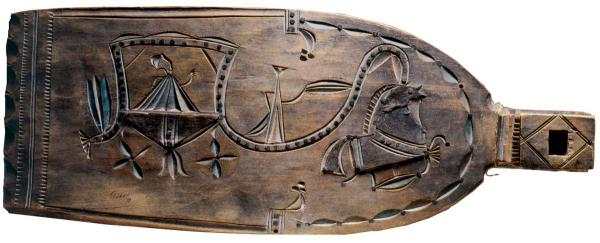The Dontse (horizontal board) of the Distaff
District of Gorodets, Nizhny Novgorod Province. Первая половина XIX века
- wood, скобчатая carving, инкрустация мореным дубом, подцветка. 15 х 28 х 72
- Д-672
Пост. в 1940 из ГИМ
-
Location in museum
The Rossi Wing,
Room 6
 Open the panorama of the hall in the virtual tour
Open the panorama of the hall in the virtual tour
- Period Early 19th century
- Share
From the end of the 18th century the center of art distaffs production was in the Nizhny Novgorod province near Gorodets in the villages of Khlebaikha, Repino, Kurtsevo, Koskovo along the right bank of the Uzola river, the Volga tributary. The art of decoration was not only concentrated on the blade (instead of which a broad maple comb was sometimes inserted), but also on the horizontal board from aspen. It was the horizontal board that was transformed by generations of masters into a kind of "picture", which was hung on the wall for decoration of the peasant's house.
The painting established there not at once. It was preceded by the unique carving, which combined with inlaid pieces of stained oak, found in the River of Uzole. Having been in the water for a long time, the wood became darker and stood out spectacularily on the light board from aspen. The Gorodets dontse is a wide short board with an oval cut on the front end, where the comb is fixed. The lug has the form of a curved heel or a truncated pyramid. Until the 1870s boads were decorated with ornamental patterns or narratives. Thus, for example, a carriage with a female figure and a coachman, was carved along the entire board; there were also pictures of riders or bird hunters, sitting on the top of a fairy-tale tree; ladies walking under umbrellas and cavaliers, servicemen marching. The details of the images (human figures, carriages, flowers) were made with the refined and dynamic technique of staple carving, supplemented with oak details. The carving is often tinted with blue, orange-red, green colors.

